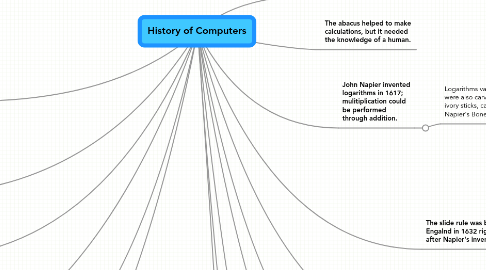
1. In 1944 Harvard and IBM had a partnership and together constructed the Mark1.
1.1. This was the first programmable digital computer made in the states.
1.1.1. The Mark 1 was constructed of switches, relays, rotating shafts and clutches; it wasn't a purely electronic computer.
1.1.1.1. It weighed about 5 tons, had 500 miles of wire, was 8 feet tall and 51 feet long; and it ran non-stop for 15 years.
2. Grace Hopper was one of the programmers for the Mark 1, and she found the computers first "bug." (It was really a dead moth.)
2.1. Since 1889 the word "bug" is used to describe a defect.
3. In 1976 the first Apple 1 computer was sold for $600.00, a home computer.
4. The microelectronics revolution is what allowed hand crafted wiring to be mass-produced as an integrated circuit(a small sliver of silicon the size of your thumbnail.)
5. The IBM Stretch computer was made in 1959, and had to be 33 feet long in order to hold its 150,000 transisitors.
6. In 1976 the Apple 1 was sold as a do-it-yourself home computer kit.
6.1. The Apple 1 sold for about $600.00
7. New node
8. People were first considered computers; it was a job title.
8.1. Repetative calculations had to be performed (usually by women.)
8.1.1. Mistakes were always made.
9. The abacus helped to make calculations, but it needed the knowledge of a human.
10. John Napier invented logarithms in 1617; mulitiplication could be performed through addition.
10.1. Logarithms values were also carved on ivory sticks, called Napier's Bones.
11. The slide rule was built in Engalnd in 1632 right after Napier's invention.
11.1. Aided the NASA engineers in the 1960's Mercury, Gemini and Apollo missions that landed man on the moon.
12. The first gear-driven machine was made in 1623, the Calculating Clock.
12.1. Invented by a German porfessor, Wilhem Schick
12.1.1. The invention got little publicity because professor Schick died of the bubonic plague shortly after.
13. The Pascaline was invented by 19 year old, Blaise Pascal in 1642.
13.1. It was a gear driven calcualtor that had only one function, it could only add.
13.1.1. It was inacurate though because at that time it wasn't possible to fabricate gears with precision.
14. A few years after the Pascaline invention the German Gottfried Wilhem Leibniz built a four function(+,-,*,/) calculator called the Stepped Reckoner.
14.1. It had 10 fluted drums arranged arounf their circumference in a stair-step fashion, instead of gears.
14.1.1. The reckoner did employ the decimal number system and Leibniz was the first to advocate use of the binary system(whcih later became fundammental in the operation of modern comouters.)
15. In 1801 Frenchman Joseph Maire Jacquard invented a power loom that could base its weave upon a pattern that was automatically read from wooded punched cards. Long ropes held these together.
15.1. It was the first machine to use punch cards. The punch cards controlled the weaving.
16. In 1822 a proposal was made by Charles Babbage to make a steam driven calculating machine the size of a room.
16.1. This machine, the Differnece Engine, would be able to compute tables of numbers, much like logarithm tables.
16.1.1. The government funded this project because of the importance of numeric tables.
16.1.1.1. The invention had hoped to correct over 100 numerical errors, but it showed to be very difficult and the project soon became very expensive.
16.1.1.1.1. Ten years later the project was still incomplete, and it was never finished.
